MORE: Ram Rebel vs. Tundra TRD Pro
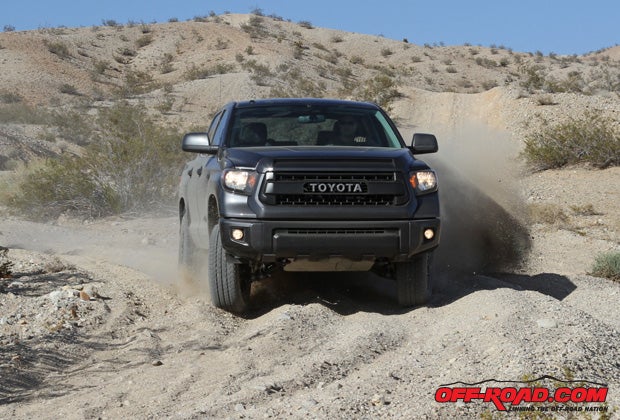
Suspension & Handling
With the enhanced trail performance of these next-level off-roaders, one important aspect can easily be overlooked: Handling. Typically as a vehicle gets fitted with a suspension lift and larger tires, oftentimes itís on-road handling and/or turning radius that is negatively impacted. Thatís not the case with these two trucks, as they actually both feature relatively similar-to-stock handling characteristics.
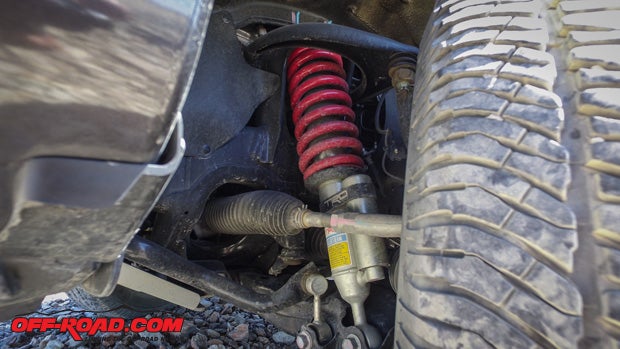
The Tundra TRD Pro was first unveiled last year as a 2015 model, and its key off-road upgrades are the suspension. The TRD Pro features a two-inch lift up front, thanks to larger Bilstein coilover shocks that help level out the truck. This front shock setup is unique compared to a standard TRD Off-Road package because the shocks bodies themselves are a larger 60mm diameter compared to the 46mm shocks are featured on non-TRD Pro models. Aside from the additional two inches of lift, they also are fitted with remote reservoirs that house additional oil to keep the shocks cool under heavy use. The TRD Bilstein coilovers also provide three-stage compression damping to adapt to the terrain, while an internal hydraulic bump stop help take out some of the harshness of bumps on the trail. To cap it off, TRD-tuned Eibach springs are fitted on the coilovers to provide the ideal balance of off-road performance while still retaining good on-road handling. Out back, TRD fits the rear suspension with the same 2.5-inch remote-reservoir Bilsteins to help compliment the TRD off-road leaf springs.
So how does all of this translate to real-world driving? Overall, the Tundra TRD Pro has a great feel both on the road and off. It has 10.6 inches of ground clearance, and in spite of the beefier suspension setup the on-road ride quality is not sacrificed. Thereís no doubt the leveled out front end is a huge improvement to the Tundra, because it not only increases ground clearance and suspension travel but also removes the ďstink bugĒ or nose-low stance. Essentially the upgraded Bilstein suspension performs the same job as an inexpensive leveling kit would do, except the coilovers offer a serious performance upgrade and arenít just for looks. The Tundraís additional ground clearance paired with the TRD Pro skid plate on the front end makes powering through whoops far less concerning than on standard stock trucks. Of the two, the Tundra has the most confident suspension package in the dirt, as it provides excellent control of the truck when the going gets rough whether on high- or low-speed trails; the suspension never feels out of tune with the truck.
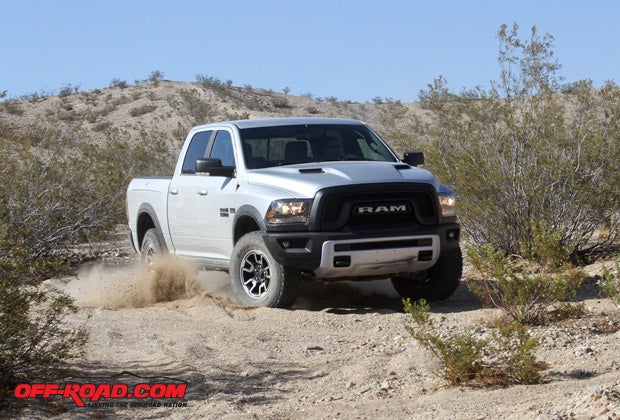
Much like the Toyota, the Ram 1500 Rebel also provides an additional two inches of front-end lift, although the way in which it achieves that lift is quite different thanks to its air suspension. The Ram doesnít offer only one suspension setting Ė in fact, itís adjustable depending upon the situation. There are four suspension settings for the Ram Rebel: Entry/Exit mode lowers the vehicle to get in and out of the truck; Aero mode lowers the truck for highway travel to improve aerodynamics for improved fuel efficiency; the ďNormalĒ mode is slightly confusing on the Rebel, because this is the standard running height for this truck but technically it is an inch higher than a 1500 model not equipped with air suspension; the final setting is Off-Road, which lifts an additional 1 inch over the Rebelís Normal ride height, which means it sits a full 2 inches higher than standard 1500s. When all is said and done, the Rebel offers 10.3 inches of ground clearance.
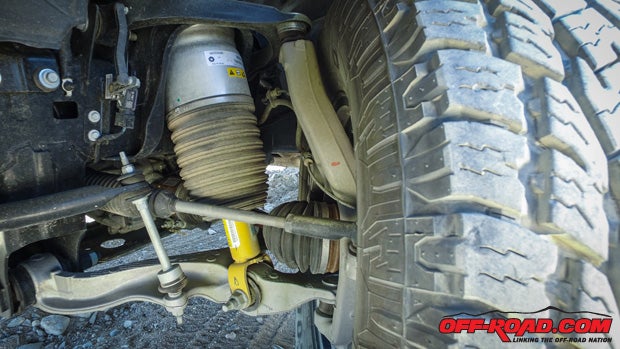
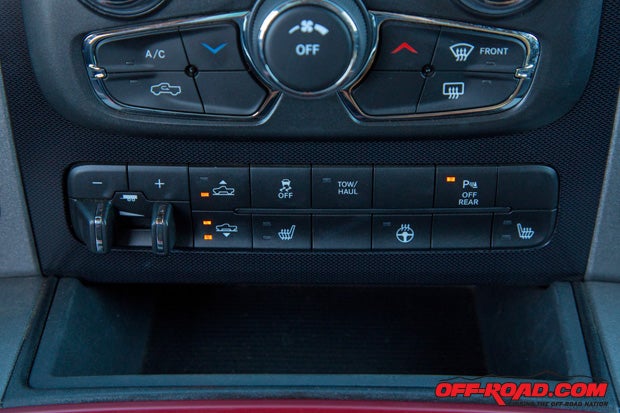
The Ram Rebel is fitted with upgraded Bilstein monotube shocks to enhance its performance. Although not quite as large as the ones found in the Tundra, the Bilsteins do a good job of soaking up the bumps in the dirt and delivering a confident and comfortable ride on the highway. The Bilstein and air suspension pairing combine to provide the best on-road handling of the two, especially in towing situations where the air suspension self levels to accommodate the weight of a loaded trailer. At slower speeds, we felt the Ramís suspension off-road was impressive, but when the pace picked up it was clear the three-stage valving of the Tundra shocks gave it the edge in performance. The Rebel was not as smooth at faster speeds and we felt there was either too much rebound in the shocks or that possibly the air suspension added extra spring coming off of bumps in these instances.
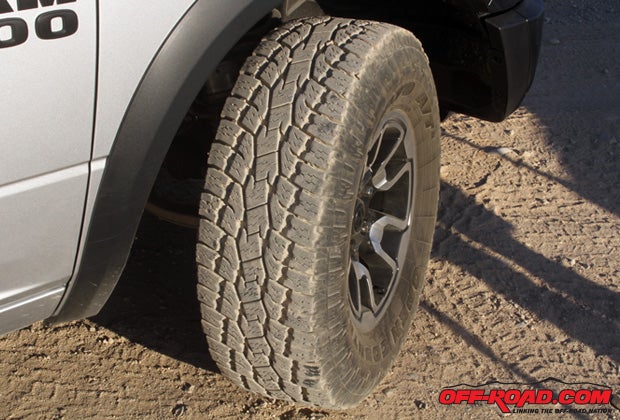
There is a slight but noteworthy difference in the tire and wheel packages on both trucks. The Rebel is equipped with 17-inch wheels fitted with 33-inch Toyo AT II tires (285/70R17), while the Tundra is equipped with 18-inch wheels and slightly smaller 32-inch Michelin LTX A/T2 tires (275/65R18). We prefer a smaller wheel on our off-road rigs for the added sidewall grip for aired-down performance, but the bigger gripe for the TRD Pro is the Michelin all-terrains being too road-friendly for our taste. The Toyos on the Ram provided great traction and are a true all-terrain, while the Michelins on the Toyota didnít offer the same bite climbing up hills.
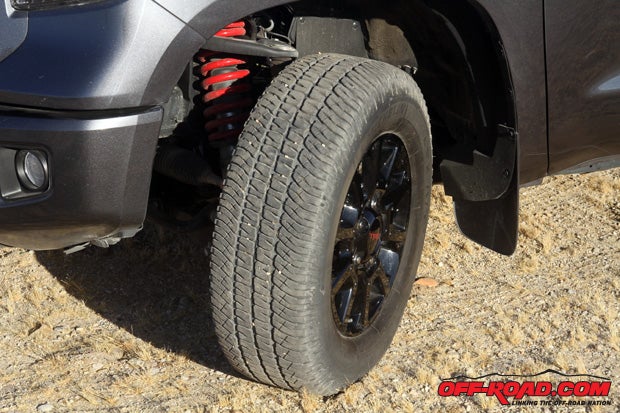
One major gripe we have for both trucks is that neither is fitted with a rear locking differential. Although both trucks do have some form of limited slip, Toyota utilizes A-TRAC on its 4x4 trucks to transfer power in both the front or rear axle to the wheel with the most traction, while the Ram uses an ďAnti-Spin DifferentialĒ rear axle for added traction. In our books, a selectable rear locker should be included on a next-level off-road package.
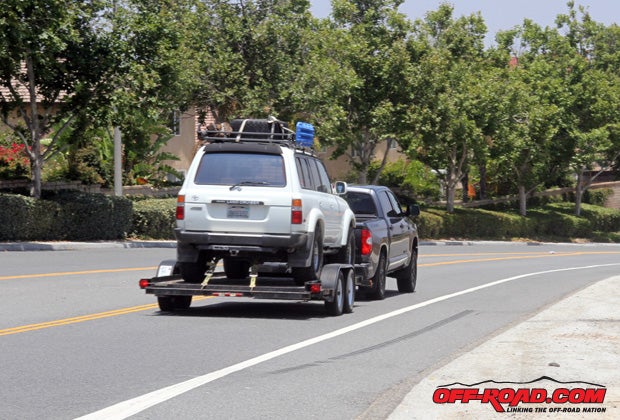
Towing
Although these trucks are fitted with upgraded parts to improve their off-road performance, weíre happy to report the modifications donít hinder their ability to tow. The Ram Rebel has a slight edge in its towing capacity at 10,160 lbs., while the Tundra TRD Pro isnít too far off at 9,800 lbs. Both trucks performed well during or tow testing, but we did notice some distinct differences between the two.
For our towing test we used a Big Tex 60-CH trailer loaded up with an 80 Series Land Cruiser, with the combined weight of our trailer/Land Cruiser tipping the scales at just over 7,300 lbs. With such a heavy load, we are pleased that both trucks feature integrated trailer brake controllers to help us dial in the electronic brakes on the Big Tex trailer.
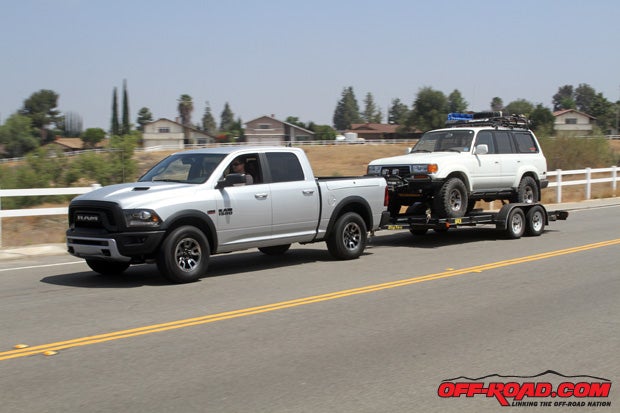
We were immediately impressed when we hooked up the trailer to the Ram Rebel, as we noticed the weight didnít sag down the rear end at all Ė in fact, the air suspension adjusted to the weight to level out the rear. We were impressed with the acceleration of the Ram as we pulled away from our first dead stop, as it clicked through the gears smoothly and didnít seem bothered by the weight all that much. When we approached our first hill, the power and torque from the HEMI V8 motored up confidently. Later we approached a very steep downhill section and were presented with our first braking test Ė a red light at the bottom of the hill. The four-wheel disc brakes offered smooth, controlled stopping power. We also noticed that the Tow/Haul mode on the Rebel did a great job of keeping the truck in the proper gear so it didnít pick up speed on the downhill section. Overall, we give very high marks to the Ram Rebel in the towing department.
The Tundra TRD Proís i-FORCE V8 engine also showed good power climbing hills during tow testing, but it didnít quite pull away from a dead stop as confidently as the Ram. Once we made it to our steepest climb, we noticed the six-speed transmission hunting for the proper gear, and the engine did tend to rev higher than the Rebel. At times, we noticed the Tundraís transmission actually shifted too early, and we lost a bit of our momentum that would rev the V8 engine higher as it shifted into a lower gear. For example, the Tundra was revving at roughly 5,000 rpm at 50 mph during our climb, whereas the Ram more effortlessly found its sweet spot at 3700 rpm. Clearly, the additional gears in the Ramís eight-speed helped.
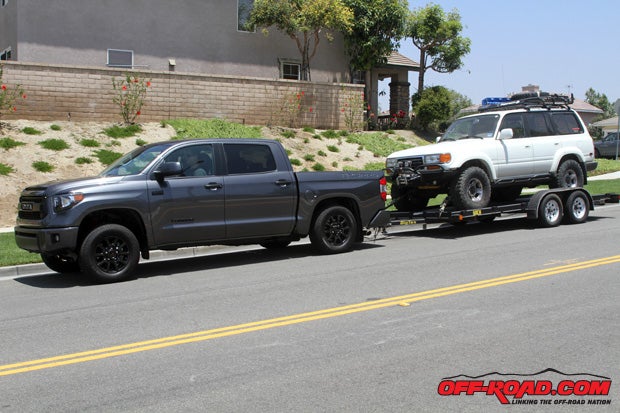
Both trucks felt comfortable and confident handling the load around turns, although the Tundra definitely squatted lower with the heavy load (helper springs from the aftermarket would help this). Coming to a stop in the Tundra wasnít quite as smooth as the Rebel either, as the load seemed to push the truck a little more when performing a complete stop at the bottom of a steep hill. We are happy to see Toyota added the trailer brake controller on the 2016 model as well, since it was a feature lacking on previous model years.


 Your Privacy Choices
Your Privacy Choices